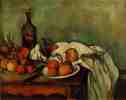 Still Life with Onions and Bottle
Still Life with Onions and Bottle
FROM THE SAME PERIOD as the anti-architectural, festive Still Life with Oranges and Apples, perhaps a bit earlier--the exact dates of Cézanne's works are not known--is this still life which combines the large constructive elements, the verticals and horizontals and the broad, bare wall, with a close-packed abundance of small curves, tilted forms, and accents of free vegetation. In the cool tones and search for rhythmic lines, it is like the Bathers, though less schematically composed. The rounded and flamboyant shapes also articulate the severest, most stable objects, as in the scalloped edge of the table and the outlines of the bottle and glass. It is one of Cézanne's most remarkable compositions, an ingenious development of lines in a musical manner, without drama or climax, and has an amazing delicacy of touch and refined richness of color within a subdued, atmospheric key. Meditative in mood, a result of the most serious meditation, it is a work to ponder and explore.
As a formal theme, the chief element is the onion, a shape more complex than the apple and congenial to Cézanne's later style through its greater flexibility of line and especially its more open, wavy form. We follow its development from left to right in groups open and closed, including the variant lemons, in ever-changing axes, spottings of color, and contacts with neighboring things. Together with the scallops of the table--an ambiguous pairing of concave and convex, of greater span than the similar curves of the onions--the billowing silhouette of the cloth, and the bottle and glass, they form a system of distinct parallel melodies which at certain points coincide.
The painting has many delightful, subtle touches; perhaps every stroke is of the same order of finesse and it is arbitrary to single out one rather than another. We may note, however, several examples within the same part, the beautifully painted wine glass. Its stem, off-axis to the right, shifts the whole away from exact alignment with the important point of meeting of two curves of the scalloped table edge below--curves related to the form of the glass stem and the base of the bottle. Through the shifting of the stem, and through the break in the outline of the ellipse in its upper left, the glass seems finely tilted, like certain of the onions with their pliant ends, and strengthens the diagonal grouping of the bottle, the glass and the onions in the plate. Another delicate, barely perceptible thought are the horizontal lines drawn inside the glass (and also the bottle); they are a discreet recurrence of the line of the table and belong with the horizontals on the lower right of the wall and an exposed bit of the table among the folds of the cloth; together, all these segments form a stepped series, with proportioned intervals. The glass itself, with the refracted onion behind it, is an amazing bit of sober painting in which the decisions, touch by touch, have an inspired daring and rightness; it could be painted thus only here, in relation to the unique structure of this harmony which it helps to constitute.
An Italian artist, admiring the subtleties of Velasquez's Las Meninas,
called it the "theology of painting." The same may be said of this
great still life of Cézanne.
-- Meyer Schapiro
The perspective of the table appears somewhat awkward; while its front runs perfectly parallel to the picture plane (with a black knife slightly protruding from it), its side shows a great divergence between the receding top and that of the scalloped board beneath it. At the same time the large folds of the white cloth seem stretched out beyond where they might be supported by the surface of the table (an incident to be observed in many of Cézanne's still-life arrangements). The paint is applied thinly--except near the bottle, which may originally have been taller and placed a little more to the right. It is there that the only impasto in the picture appears, as though the bottle had at first been almost touching the stemmed glass and then, possibly, put directly over a second glass, whose oval rim can be detected. However, this oval rim does seem to have been traced on top of the belly of the bottle.
The colors are light and rich in delicate gradations. The onions vary
from almost white to pink and red; there are a few yellow fruit among
them, especially one at the extreme left, while the wainscot at the
right bottom is slightly darker than the wood of the table. In the
folds of the hanging white cloth appear subtle tonalities of
green. The colors seem to relate this work stylistically to the
Geffroy portrait of 1895 and the Bibemus landscape of c. 1897;
Gowing's suggestion of c. 1895 is of course also acceptable, yet even
earlier dates, such as 1890-94, have been proposed. This graceful,
subtle, and indefinably felicitous work seems to stand on the
threshold of a new phase in Cézanne's evolution, where his strokes
become increasingly heavy with pigment, where his brushwork appears
more vibrant though his execution often seems labored, where the
surfaces of his pictures are less smooth, where his colors sometimes
show a tendency to turn darker, but where his concepts transcend any
realistic approach and reach the glorious detachment and freedom, the
intense and fierce attitude toward nature, of his last years.
-- John Rewald
Thanks to the BMW Foundation, the WebMuseum mirrors, partners and contributors for their support.